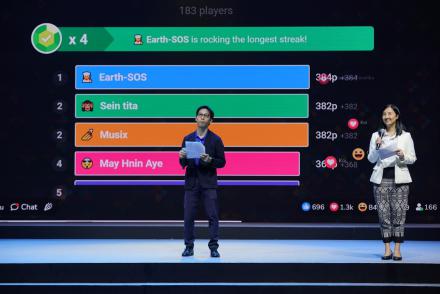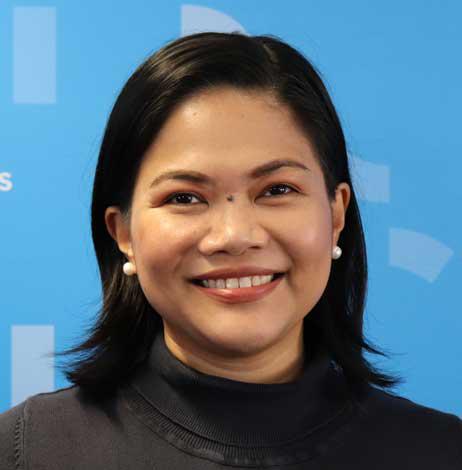
Viral, fun, and free: The new era of sustainable development learning
In today's fast-paced world, sustainable development learning formats must evolve to keep up. Traditional e-learning courses often feel like digital textbooks—long, dense, and difficult to complete. But what if learning about the SDGs felt more like scrolling through your favorite social media feed, joining a live concert, or playing with LEGO?
At the UNSSC Knowledge Centre for Sustainable Development, over 100,000 learners have engaged with open, free learning experiences over the past two years—proving that when learning is accessible and engaging, people show up. In a world driven by digital transformation and fast content consumption, KCSD is reimagining how we learn about sustainable development. Here’s what we’ve learned along the way:
Lesson 1: Microlearning is the future (bite-sized and social media-style)
Ever heard of learning in 60 seconds? If social media can teach people how to cook, dance, and even invest in stocks in under a minute, why not use the same approach for sustainable development?
- Snackable lessons – Instead of long modules, we offer short, mobile-first videos, infographics, and real-world quizzes.
- Swipe-friendly design – Mobile-first learning makes learning as easy as scrolling on Instagram or TikTok, but for SDG content.
- Instant application – Learners try out ideas immediately, not months later.
Example: Alternative: Our Thai SDG Micro-Primer demonstrated strong initial engagement, with nearly all recipients opening the mobile-based microlearning link. Learners actively participated in the interactive content, completing the Thai and English versions between 17% to 26% of quizzes, knowledge checks, and open-ended reflection questions—highlighting the potential of mobile-first microlearning to reach and engage users effectively.
NEW: The Micro-Path learning model now personalizes these bite-sized experiences, letting learners create their own journey through sustainable development knowledge at their own pace. See it here.
Learn more: A milestone year for the Thai SDG micro-primer: Empowering youth for sustainable action, Case Story - Inspiring Youth in Thailand to Act on the SDGs

Lesson 2: Make learning addictive (gamification works!)
A lot of people love challenges, leaderboards, and instant rewards—so why not apply the same principles to sustainable development learning? Instead of static lessons, we’ve incorporated:
- Badges and rewards – Earnable rewards keep learners motivated.
- Quizzes and challenges – Quick tests with real-time feedback increase engagement.
- Community leaderboards – Seeing progress compared to peers drives competition and motivation.
Example: Our My Sustainable Lifestyles engaged approximately 3,022 participants globally across 88 countries and is available in English, Spanish, French, and Russian, thanks to competitive, gamified design.
Learn more : Gamified learning: Nudging young people through the ‘My Sustainable Lifestyles Challenge’

Lesson 3: The more interactive, the better
Forget static PowerPoints. Interactivity is king. Learners don’t just want to read—they want to experience and immerse themselves in sustainable development learning.
- Virtual Reality (VR) case studies – Interactive simulations transport learners into real-world challenges in immersive 360°.
- Live quizzes and polls – Real-time interaction makes learning lively similar to a trivia night at your local pub.
- Scenario-based learning – Real-world problem-solving keeps learning practical.
Example: Our VR learning experiences let users walk through sustainable transitions—virtually.
NEW: We’ve added AI-powered adaptive learning, which personalizes pathways based on what learners know (and don’t). We also incorporate LEGO Serious Play and Improv Theater in live workshops to boost creativity, reflection, and team learning.
Learn more: UNSSC Virtual Reality Presentation

Lesson 4: Learning can be artistic and experiential
Who says learning isn’t also a concert, a treasure hunt, or a poetry jam?
- We hosted a concert with the City of Bonn, where songs were poems about inclusion and diversity.
- Partnered with a music group in Amsterdam using concerts on a boat to teach and live out sustainability, building communities of musicians passionate about change.
- Treasure hunts and scavenger hunts now bring learning to parks, campuses, and even Zoom rooms.
- Trend talks and shair fairs at the UN Summer Academy bring real stories, open dialogue, and spontaneous inspiration to life.
Learn more: The UN Summer Academy: Join an Exceptional Group of Changemakers
Lesson 5: Free, open, and accessible learning wins every time
Paywalls create barriers. Open learning creates opportunity.
UNSSC has prioritized free and accessible courses and multilingual content to break down learning barriers.
- No cost, high impact – Our moderated online and self-paced courses are free and open-access, thanks to the generous contribution of our donors like the Federal Republic of Germany.
- Multilingual reach – We localize content so knowledge spreads far and wide.
Example: UNSSC’s Digital4Sustainability Learning Path attracted 22,000+ learners.
NEW: Through UN SDG:Learn, UNSSC also post regular lists of free online courses on social media—these posts alone attracted nearly 7 million impressions in 2023 and over 5 million in 2024 (and counting). It’s proof that when learning is free and easy to access, the world pays attention. Listen here.
Lesson 6: Dedicated tutors skyrocket completion rates and engagement
Human connection drives commitment. Having a dedicated tutor or facilitator increases course completion rates and engagement dramatically—even in large-scale online programmes.
- One of our moderated courses achieved a 96% completion rate—even with over 1,000 learners!
- Real tutors leads to real engagement – Weekly feedback, live discussions, and community spaces.
Example: In The Paris Agreement as a Development Agenda course, peer exchange and expert-led dialogue kept participants energized and on track.
Lesson 7: Peer learning for high-level impact
For senior leaders and changemakers, learning is less about content and more about connection, strategy, and insight-sharing. With this in mind, we’ve launched the UN Mastermind Group—a curated peer learning space where UN leaders and system actors come together to exchange ideas, unpack challenges, and learn from one another.
- Real-time strategy sharing – Leaders bring their toughest dilemmas and get cross-sectoral input.
- Confidential, facilitated dialogue – Trust-based sessions foster deep reflection and innovation.
- Peer coaching – Not just learning about change but learning how to lead it.
Why it works: This space builds collective wisdom—across agencies, geographies, and leadership levels—while driving alignment and action on sustainable development.
Learn more: Why sustainable development leaders need a mastermind group
At UNSSC, we’re not just delivering sustainable development learning—we’re reimagining how learning happens. From gamified challenges and microlearning to VR, AI, theater, and music, we’re blending high tech and human touch to create learning that’s irresistible, inclusive, and transformative.
Whether you’re a frontline practitioner or a UN leader shaping global strategy, we believe learning should be viral, fun, and free. If you are interested in working with us in developing innovative learning formats for your specific needs, please reach out at sustainable-development@unssc.org.

